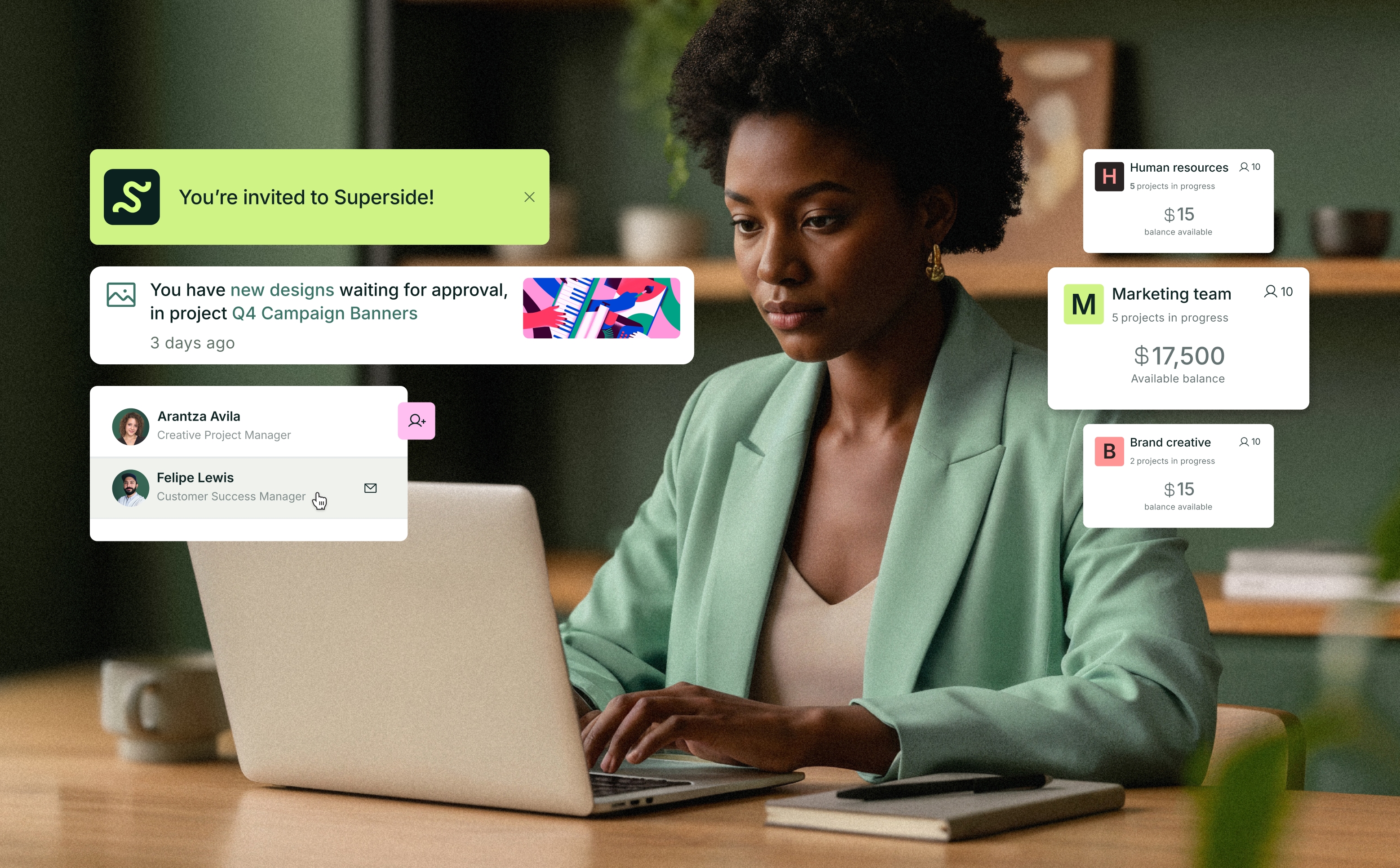
Did you ever walk down the street, smell French fries and immediately know there's a McDonald's nearby? Or maybe you see an ad on TV, and you know it’s a Coca-Cola commercial long before they even show the logo?
That’s branding done right. These are the companies who know their brand well and have ingrained their imagery in your mind.
Building a brand identity is an intimate process that entails understanding your company's values and outward image. You can learn how to create a strong brand identity that will stick in consumers' minds by understanding how top brands did it and with our tips and tricks.
To get you started on this brand identity journey, this post will cover the following:
What is Brand Identity?
Brand identity is the collection of elements a company creates to portray the right image to its consumers. It's like the face of your company, the first thing people see when they encounter your brand. But it goes beyond just visuals. It's also about how your brand makes people feel and what it stands for.
Brand identity is the collection of all elements that a company creates to portray its image to its consumers. It includes visual elements, but also encompasses the feelings and values associated with the brand.
The Power of a Strong Brand
Now that we've established what brand identity is and why it's important, let's delve into the power of a strong brand.
A strong brand is like a lighthouse in the stormy sea of the marketplace, guiding customers towards it. But what makes a brand strong? And how does a strong brand identity contribute to business growth?
Case Studies of Successful Brands
Let's look at some examples. With its iconic logo and commitment to innovation, Apple has built a brand identity synonymous with quality and cutting-edge technology.
With its empowering "Just Do It" slogan and swoosh logo, Nike has created a brand identity that stands for athleticism and motivation. These brands have leveraged their strong brand identities to dominate their respective markets.
The Correlation Between Strong Brand Identity and Business Growth
A strong brand identity doesn't just make your brand look good; it also contributes to business growth. It helps to differentiate your brand in the marketplace, attract and retain customers, and build brand loyalty. Moreover, a strong brand identity can command a price premium and increase the value of your business.
Step-by-Step Guide to Building a Brand Identity
Creating a brand identity isn't something that happens overnight. It's a process that requires careful thought, strategic planning, and a deep understanding of your brand's core values and mission. Here's a step-by-step guide to help you build a brand identity that truly represents your brand and resonates with your target audience.
Step 1: Conducting a Thorough Brand Audit
Before building a new brand identity, you need to understand where your brand stands. A brand audit involves analyzing your brand's current market perception, competitors, and your target audience's expectations. Here's how to do it:
- Analyze your current brand elements: Look at your logo, color palette, typography, imagery, website, and social media presence.
- Are they consistent?
- Do they accurately represent your brand?
- Are there elements that are outdated or no longer relevant?
- Understand your audience: Conduct surveys, interviews, or focus groups to understand how your audience perceives your brand.
- What words do they associate with your brand?
- What do they like or dislike about your brand?
- How does your brand compare to their ideal brand in your category?
- Study your competitors: Identify your main competitors and analyze their brand identities.
- What can you learn from them?
- How can you differentiate your brand from theirs?
- What elements of their brand identity are most appealing to your target audience?
Step 2: Establishing Your Unique Value Proposition and Messaging Statements
Your unique value proposition (UVP) is what sets you apart from your competitors. It's the unique value you promise to deliver to your customers. Your messaging statements, on the other hand, are the key messages you want to communicate to your audience. Here's how to establish your UVP and messaging statements:
- Identify your brand's strengths: What does your brand do better than anyone else? What unique value do you offer to your customers?
- List down your brand's strengths.
- Identify the unique value you offer to your customers.
- Understand your customers' needs: What problems does your brand solve for your customers? What benefits do they get from your products or services?
- Conduct market research to understand your customers' needs.
- Identify the problems your brand solves for your customers.
- Craft your UVP and messaging statements: Based on your brand's strengths and your customers' needs, craft a UVP that clearly communicates the unique value you offer. Similarly, create messaging statements that convey your key brand messages.
- Write a clear and concise UVP.
- Create messaging statements that convey your key brand messages.
Step 3: Developing Your Brand's Creative Elements
Your brand's creative elements, such as your logo, color palette, typography, and imagery, play a crucial role in your brand identity. They should visually represent your brand and be consistent across all your brand touchpoints. Here's how to develop your brand's creative elements:
- Design your logo: Your logo is the face of your brand. It should be simple, memorable, and representative of your brand.
- Sketch out logo ideas.
- Test different designs with your target audience.
- Choose your color palette: Colors evoke emotions. Choose colors that reflect your brand's personality and make your brand stand out.
- Research color psychology.
- Choose a primary color and secondary colors that complement it.
- Select your typography: The fonts you use should be legible and consistent with your brand's personality.
- Choose a primary font for your headlines and a secondary font for your body text.
- Ensure your chosen fonts are legible and accessible.
- Define your imagery style: The images you use, whether they're photos, illustrations, or icons, should have a consistent style that aligns with your brand.
- Determine the type of imagery that best represents your brand (e.g., realistic photos, illustrations, abstract shapes).
- Establish guidelines for your imagery (e.g., color scheme, composition, subject matter).
Step 4: Implementing Strategies to Establish the Brand Identity
Once you've created your brand identity, it's time to implement it. This involves integrating your brand identity into all your brand touchpoints and communicating it to your audience. Here's how to do it:
- Integrate your brand identity into all your brand touchpoints: From your website and social media profiles to your marketing materials and packaging, ensure that your brand identity is consistently represented.
- Update your website and social media profiles with your new logo, color palette, typography, and imagery.
- Ensure your marketing materials and packaging align with your new brand identity.
- Communicate your brand identity to your audience: Use your messaging statements to communicate your brand identity to your audience. Make sure your brand's voice is consistent across all communication channels.
- Develop a communication plan to announce your new brand identity to your audience.
- Ensure your brand's voice is consistent across all communication channels.
Step 5: Analyzing and Refining the Brand Identity
Building a brand identity is an ongoing process. It requires regular analysis and refinement to ensure that it remains relevant and effective. Here's how to analyze and refine your brand identity:
- Monitor your brand's performance: Use brand tracking tools to monitor your brand's performance over time. Are you achieving your brand objectives? How is your brand perceived in the market?
- Set up brand tracking tools to monitor your brand's performance.
- Regularly review your brand's performance metrics.
- Gather feedback from your audience: Regularly gather feedback from your audience to understand how they perceive your brand. Are there any aspects of your brand identity that are confusing or off-putting?
- Conduct surveys or interviews to gather feedback from your audience.
- Use social listening tools to monitor online conversations about your brand.
- Refine your brand identity: Based on your analysis and feedback, refine your brand identity as needed. This could involve tweaking your logo, adjusting your color palette, or revising your messaging statements.
- Make necessary adjustments to your brand identity based on your analysis and feedback.
- Continually refine your brand identity to ensure it remains relevant and effective.
By following these steps, you can create a strong brand identity that accurately represents your brand, resonates with your audience, and helps you stand out in the market.
The Importance of Brand Guidelines in Brand Identity
Brand guidelines, also known as a brand style guide, are a set of rules and standards that dictate how your brand should be presented across various platforms. They are a crucial part of maintaining a consistent brand identity.
Brand guidelines are the blueprint for maintaining a consistent and recognizable brand. They help ensure that all aspects of your brand, from your logo to your messaging, are consistently and accurately represented across all platforms and touchpoints.
Here's why brand guidelines are so important:
- Consistency: Brand guidelines ensure consistency across all platforms and touchpoints. This consistency helps to reinforce your brand identity and makes your brand more recognizable to your audience.
- Efficiency: With clear brand guidelines, your team can work faster and more efficiently. They won't have to guess about how to represent your brand – they'll have clear instructions to follow.
- Differentiation: Brand guidelines help your brand stand out from the crowd. They ensure that your unique brand elements are consistently represented, helping to differentiate your brand from your competitors.
- Brand Loyalty: Consistent, recognizable brands are more likely to earn the loyalty of their customers. When customers recognize and resonate with your brand, they're more likely to stay loyal to it.
Creating brand guidelines involves defining key elements of your brand identity, such as your logo, color palette, typography, and messaging. These elements should be clearly outlined in your brand guidelines, along with instructions on how to use them.
Here's a step-by-step guide on how to create brand guidelines:
- Define your brand elements: Outline your logo, color palette, typography, and any other visual elements that make up your brand identity. Include specific details, such as color codes and font names.
- Outline your brand messaging: Include your brand's unique value proposition, mission statement, and any other key messaging.
- Provide usage guidelines: Explain how your brand elements should be used. This could include instructions on logo placement, color usage, and typography.
- Include examples: Provide examples of what correct and incorrect usage of your brand elements looks like. This can help to clarify your guidelines and prevent misuse.
- Keep it accessible: Make sure your brand guidelines are easily accessible to all members of your team. This could involve creating a digital version of your guidelines that can be easily shared and updated.
By creating and adhering to brand guidelines, you can ensure that your brand identity remains consistent, recognizable, and impactful.
How to Improve Your Brand Identity: Key Strategies
Improving your brand identity involves refining your existing brand elements and strategies to better resonate with your audience and stand out in the market. Here are some key strategies to improve your brand identity:
Improving your brand identity is about refining your existing brand elements and strategies. This can involve updating your logo, revising your messaging, or redefining your brand's visual style.
Update Your Logo
Your logo is the face of your brand. If it's outdated or no longer resonates with your audience, consider updating it. This doesn't necessarily mean a complete redesign. Sometimes, a simple refresh can make a big difference.
- Consider a logo refresh: If your logo is outdated or no longer resonates with your audience, consider a refresh. This could involve updating the colors, refining the design, or modernizing the typography.
- Ensure your logo is versatile: Your logo should work well in various sizes and formats. It should look good on your website, social media profiles, marketing materials, and packaging.
Revise Your Messaging
Your brand messaging should clearly communicate your brand's unique value proposition and personality. If your messaging is unclear or doesn't resonate with your audience, consider revising it.
- Clarify your unique value proposition: Your unique value proposition is what sets you apart from your competitors. Make sure it's clearly communicated in your messaging.
- Ensure your messaging is consistent: Your messaging should be consistent across all platforms and touchpoints. This helps to reinforce your brand identity and makes your brand more recognizable.
Redefine Your Visual Style
Your visual style, including your color palette, typography and imagery, plays a crucial role in your brand identity. If your visual style is inconsistent or doesn't reflect your brand personality, consider redefining it.
- Update your color palette: If your color palette is outdated or doesn't reflect your brand personality, consider updating it. Choose colors that evoke the emotions you want to associate with your brand.
- Refine your typography: Your typography should be legible and reflect your brand personality. If your current typography doesn't meet these criteria, consider refining it.
- Establish a consistent imagery style: Your imagery should have a consistent style that aligns with your brand. If your current imagery is inconsistent or doesn't reflect your brand, consider establishing a new imagery style.
By implementing these strategies, you can improve your brand identity, making it more impactful and resonant with your audience.
Inspiring Examples of Brand Identity
Looking at successful, worldwide-recognized brand identity examples can provide a wealth of inspiration and insight. Here are five examples of brands with strong identities:
The following brands have created strong identities that are instantly recognizable and effectively communicate their brand values and personality.
1. Airbnb
Airbnb has not only changed the way we travel but also the way brand design is done. Starting with the ‘Belong Anywhere’ creative proposal, every brand element and brand asset was transformed to match the new identity. The design agency's process started with trying the Airbnb service. 18 hosts, 13 cities, 90 days spent at the HQ, and 120 employee interviews later, the branding agency had gathered enough insight to build a creative strategy. The new identity logo design became a symbol of Airbnb’s values and community – one that people share proudly.
The next step was to bring the new branded identity to life online and on the go. They went above and beyond and built a platform where community members could create their own version of the logo.
2. Give London
Give London is a charity fundraising initiative that targets overlooked local charities and aims to help people support different issues like child poverty, isolation, or education. Their brand-building process started from the idea of "local giving" and telling the stories of many unknown charities.
The logo, even if it is abstract, creates a strong emotional connection. The imagery was carefully chosen, and the color palette and typography keep things clean and simple, drawing your attention to the message.
3. Misfit
Misfit is a company that repurposes vegetables and fruit that would go to waste because they are not aesthetically attractive and uses them to create cold-pressed juice. In 2017, they challenged beauty standards and color chemes with a new identity consistent with their values and mission.
They told the story through illustration, web design, and photography, redesigning the brand into a fun and approachable one. They created a new logo that is a deliberate misfit and works perfectly with the abstract illustrations. It is a terrific example of a brand growing and evolving.
4. Barre and Soul
Barre and Soul is a yoga and fitness company that managed to create a cohesive visual identity. They started with a mood board picturing the brand as energetic, retro, and edgy. To support this description, they chose bold, feminine colors and created a playful, free-spirited logo. They carefully chose images that can be used as logo background without obstructing it. They emphasized the retro and bold characteristics with the font choice and used blue, yellow, and orange to convey the brand’s energy.
5. Casper
Casper is more than a mattress company, and they made sure their brand identity conveys the right message. In an industry that companies with complicated jargon overpopulated, they saw an opportunity and created an effortlessly simple brand. The visual identity design process consisted of creating a clear identity, a brand system, a packaging design that was consistent with their brand values, and a clear set of brand guidelines.
Common Mistakes in Building a Brand Identity and How to Avoid Them
Creating a brand identity is a delicate process that requires careful thought and planning. However, even the best of us can make mistakes. Here are some common pitfalls in brand identity creation and strategies to avoid them.
Lack of a Clear Brand Purpose
A brand without a purpose is like a ship without a compass. It's crucial to define what motivates your company to exist and what problems you are trying to solve. This allows you to be more intentional and relatable to your audience. To avoid this mistake, ask yourself: What change do you want to make? What makes you unique? Why should you be trusted?
Inconsistency in Brand Presentation
Consistency is key in brand identity. Presenting your business differently across various platforms can confuse your audience and negatively affect your brand. To avoid this, ensure that your brand is presented the same way across all platforms and touchpoints.
Absence of a Style Guide
A style guide serves as a rulebook for your brand's design elements. It ensures that whether you're working with an in-house or freelance designer, they know what design elements are on-brand and which ones aren't. To avoid confusion and inconsistency, create a comprehensive style guide that includes logo and design variations, typography, colors, social media assets, and document letterheads.
Lack of Originality
Your brand identity should be unique and distinguishable from others. Copying another brand's identity can confuse your audience and may put you at risk for trademark and copyright infringement. To avoid this, conduct thorough research to ensure your brand identity is original and does not resemble other brands.
No Defined Target Audience
Trying to appeal to everyone is a common mistake in brand identity creation. Identifying your target audience and tailoring your communication and presentation to appeal to them is essential. To avoid this mistake, evaluate your audience's demographics and create a buyer persona to understand their interests, likes, and dislikes better.
Settling for a Poor Logo Design
Your logo is the face of your brand, and it should be as memorable and eye-catching as possible. Settling for a poor design can make your brand appear unprofessional and forgettable. To avoid this, invest time and resources in creating a logo that is simple, balanced, and representative of your brand's traits and goals.
The Role of Brand Identity in Different Industries
Retail
In the retail industry, brand identity is often the deciding factor for consumers. A strong, recognizable brand can drive customer loyalty and repeat purchases. It's not just about the logo or color scheme; it's about creating a holistic shopping experience that aligns with the brand's values and promises.
For instance, a luxury brand might focus on creating an exclusive, high-end feel, while a sustainable brand would emphasize eco-friendly practices and materials.
Technology
In the tech industry, where innovation is the name of the game, brand identity can help a company stand out in a crowded market. Tech companies often use their brand identity to highlight their innovative spirit, cutting-edge solutions, and commitment to improving the user experience.
For example, Apple's brand identity revolves around innovation, sleek design, and premium quality, which is consistently reflected in their products and marketing.
Healthcare
In the healthcare sector, trust and reliability are paramount. Therefore, a healthcare brand's identity should emphasize these qualities. This can be achieved through a professional and consistent visual identity, clear and empathetic communication, and evidence of expertise and accreditation.
A healthcare brand might also focus on a specific aspect of health, such as wellness, prevention, or specialized care, to further differentiate itself.
Food and Beverage
In the food and beverage industry, a brand's identity can influence how consumers perceive the taste and quality of its products. This sector often uses brand identity to highlight specific qualities like organic ingredients, unique flavors, or ethical sourcing practices.
For instance, a craft beer brand might emphasize its unique brewing process and flavor profiles, while a coffee brand might highlight its fair-trade beans and roasting process.
Financial Services
A strong brand identity can help a company appear more reliable and trustworthy in the financial services industry, where trust and security are crucial. Financial brands often use their identity to emphasize their stability, expertise, and commitment to customer service.
For example, a bank might focus on its long history and commitment to security, while a fintech startup might highlight its innovative solutions and user-friendly interface.
FAQs on Brand Identity
Brand identity is a complex topic, and it's natural to have questions. Here are some frequently asked questions about brand identity, along with their answers:
What is Brand Identity?
Brand identity is the visible elements of a brand, such as color, design, and logo, that identify and distinguish the brand in consumers' minds. It's the way a brand presents itself to the world and how it communicates its personality, values, and promise to consumers.
Why is Brand Identity Important?
Brand identity is crucial because it helps to distinguish your brand from competitors, creates a consistent presence across different platforms, and helps to attract and retain customers by building familiarity and trust.
How Does Brand Identity Benefit Customers?
A strong brand identity can make customers feel more confident about purchasing from you. It can also create a sense of belonging or alignment with your brand's values, which can foster loyalty and advocacy.
How Can I Improve My Brand Identity?
Improving your brand identity can involve refining your logo, revising your messaging, or redefining your visual style. It's also important to ensure that your brand identity is consistently represented across all platforms and touchpoints.
What is a Brand Identity Guide?
A brand identity guide, or brand guidelines, is a document that outlines how your brand should be presented. It includes specifics about your logo, color palette, typography, imagery, and messaging, along with instructions on how to use these elements.
What to Keep in Mind About Building a New Brand Identity
Designing a brand identity is not an easy thing to do. It takes time, work, and a lot of brainstorming. Keep these do's and don’ts in mind.
Do:
- Stand out and be memorable – discover what sets you apart from the competition and use it to your advantage
- Create a scalable and flexible visual identity that can grow and evolve with your company.
- Make your brand strategy clear and intuitive which will make the designer's job easier.
- Be consistent with your brand elements so they are cohesive.
- Look at what others are doing. Follow best practices to find inspiration and stay informed.
Don't:
- Solely focus on how you see the brand. Take time to understand your audience.
- Limit brand identity with insufficient guidelines.
- Get carried away with data visualization.
- Be redundant or use extremely abstract iconography.
- Overdo fonts and colors. Stick with two primary colors, three to five complementary colors, two accent colors, and two to three fonts.
Are you still struggling with the identity design process and don’t know how to grasp it? Let’s chat so our visual identity experts can help you find the right solution for your brand and business. Our designers are ready to put their creative minds to work for you.
Here is a video you should check out before you set out to create your own brand identity:


















